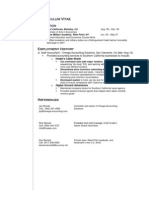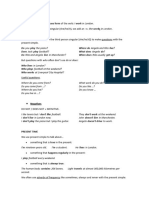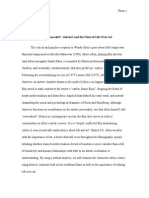Sabk
Sabk
Uploaded by
Engr HafeezullahCopyright:
Available Formats
Sabk
Sabk
Uploaded by
Engr HafeezullahCopyright
Available Formats
Share this document
Did you find this document useful?
Is this content inappropriate?
Copyright:
Available Formats
Sabk
Sabk
Uploaded by
Engr HafeezullahCopyright:
Available Formats
See discussions, stats, and author profiles for this publication at: https://www.researchgate.
net/publication/310901789
Sabkha
Chapter · January 2016
DOI: 10.1007/978-3-319-12127-7_248-1
CITATIONS READS
0 303
2 authors:
Matthew Mcmackin William Godwin
6 PUBLICATIONS 7 CITATIONS
Salinian Geoconsulting
28 PUBLICATIONS 44 CITATIONS
SEE PROFILE
SEE PROFILE
Some of the authors of this publication are also working on these related projects:
Encyclopedia of Engineering Geology View project
All content following this page was uploaded by William Godwin on 02 September 2018.
The user has requested enhancement of the downloaded file.
S
Sabkha deposits of deflated soil may contain larger salt crystals,
including clustered gypsum crystals known as desert roses.
Matthew McMackin1 and William H. Godwin2 Below stable sabkha surfaces, salts may accumulate within
1
Gardnerville, NV, USA the upper 0.5 m layer to form a salt-cemented soil, such as
2
Carmel, CA, USA gypcrete, that can provide limited strength to sabkha soils.
Aragonite, gypsum, and halite are common in coastal
sabkhas of the Red Sea (Banat et al. 2005), typical of
Synonyms seawater-fed sabkhas. Coastal sabkhas in the Arabian Gulf
are associated with dolomitization of aragonite and the depo-
Salina; Salt flat; Salt pan sition of gypsum in shallow sediments (Patterson and Kins-
man 1982).
Coastal sabkhas form in the supratidal zone where inter-
Definition mittent flooding by seawater saturates soils and deposits
evaporate salts (Glennie 1998). Seasonal tides can alter the
This is an Arabic term for salt flats found in the deserts and water table and cause local flooding of back beach areas.
coastal areas of the Arabian Peninsula and North Africa. The Soluble salts that add strength to sabkha soils may dissolve,
type locality is the Sabkha Matti, at the boundary of the changing soil properties abruptly. Weak, saturated soils can
United Arab Emirates and Saudi Arabia. Similar environmen- extend several meters below the surface.
tal conditions are recognized in other arid regions where Sabkha soils can be difficult to manage for engineering
evaporite minerals are deposited. purposes. Seasonal saturation can make soils susceptible to
liquefaction or rapid loss of bearing capacity, as shown on
Fig. 1. Reduced durability of concrete from attack by salt is
Characteristics common in the Arabian Peninsula, with chloride being more
problematic in hot-humid coastal environments (Haque
The sabkha landscape includes salt flats, salty soils (halosols), et al. 2006). The deposition or dissolution salts in the soil
scoured sand plains, and sand dunes. Wind erosion commonly can cause heaving or subsidence. Phase changes between
forms a sabkha plain, known as a Stokes surface (Fryberger gypsum and anhydrite in sabkha soils can cause volumetric
et al. 2006), where the strength of cohesion from water or change of as much 40 % resulting in heaving or subsidence
crystalline salt is sufficient to bind sand grains in place. (Azam 2007).
Windblown sand deposits may contain significant portions
of salt-cemented silt-sand pellets and crystalline salt. Lag
# Springer International Publishing AG 2017
P.T. Bobrowsky, B. Marker (eds.), Encyclopedia of Engineering Geology,
DOI 10.1007/978-3-319-12127-7_248-2
2 Sabkha
Sabkha, Fig. 1 Front end loader
stuck while attempting to recover
a truck and trailer mired on an
unimproved road in sabkha terrain
in the UAE. The road had been
passable for the previous 3 months
(Photograph, M. McMackin 2010)
References Glennie K (1998) The desert of southeast Arabia: a product of quaternary
climate change. In: Alsharhan AS, Glennie KW, Whittle GL, Kendall
Azam S (2007) Study on the geological and engineering aspects of GGSC (eds) Quaternary climate change. Balkema, Rotterdam
anhydrite/gypsum transition in Arabian Gulf coastal deposits. Bull Haque MN, Al-Khaiat H, John B (2006) Proposals for a draft code for
Eng Geol Environ 66:177–185 designing durable concrete structures in the Arabian Gulf. Arab J Sci
Banat KM, Howari FM, Kadi KA (2005) Water chemical characteristics Eng 31(1C):205
of the Red Sea coastal Sabkhas and associate evaporite and carbonate Patterson RJ, Kinsman DJJ (1982) Formation of diagenetic dolomite in
minerals. J Coast Res 21(5):1068–1081 Coastal Sabkha along Arabian (Persian) Gulf. AAPG Bull 66(1):28
Fryberger SG, Schenk CJ, Krystinik LF (2006) Stokes surfaces and the
effects of near-surface groundwater-table on Aeolian deposition.
Sedimentology 35(1):21–41
View publication stats
You might also like
- Rosenshines Principles in Action - Tom SherringtonDocument85 pagesRosenshines Principles in Action - Tom Sherringtondrekec pekec100% (2)
- Road Construction On Sabkha SoilsDocument6 pagesRoad Construction On Sabkha Soilsganguly147147No ratings yet
- LONGMAN. Carbonate Diagenetic Textures From Nearsurface Diagenetic PDFDocument27 pagesLONGMAN. Carbonate Diagenetic Textures From Nearsurface Diagenetic PDFJose Javier Marquez PradaNo ratings yet
- SabkhaDocument2 pagesSabkhaEngr HafeezullahNo ratings yet
- Definition of SabkhaDocument91 pagesDefinition of SabkhaDaniel FrancoNo ratings yet
- Sabkha Soil CE 498 Abdulwahab Mubarki Report 1Document26 pagesSabkha Soil CE 498 Abdulwahab Mubarki Report 1Astrid Aubry100% (1)
- View ContentDocument10 pagesView ContentRahul KolateNo ratings yet
- Causes of Land Subsidence in The Kingdom of Saudi ArabiaDocument7 pagesCauses of Land Subsidence in The Kingdom of Saudi ArabiaRebiai FaroukNo ratings yet
- 7) Improvement and Characterization of Sabkha Soil PDFDocument11 pages7) Improvement and Characterization of Sabkha Soil PDFMuhammad ImranNo ratings yet
- Goodall Et Al 2000 - Surface and Subsurface Sedimentary Structures Produced by Salt CrustsDocument20 pagesGoodall Et Al 2000 - Surface and Subsurface Sedimentary Structures Produced by Salt CrustsLuiz SaturninoNo ratings yet
- IPA03-G-152 East KalimantanDocument14 pagesIPA03-G-152 East Kalimantanh77hptc6vkNo ratings yet
- 277 Duss Maury Sanf Santa 2004 DrillingaroundsaltstressesrisksuncertaintiesDocument13 pages277 Duss Maury Sanf Santa 2004 DrillingaroundsaltstressesrisksuncertaintiesJoe LyNo ratings yet
- SPE Estimating Fracture Gradient in Gulf of Mexico Deepwater, Shallow, Massive Salt SectionsDocument9 pagesSPE Estimating Fracture Gradient in Gulf of Mexico Deepwater, Shallow, Massive Salt SectionsTHiago LOpesNo ratings yet
- Pengantar Geotek ARf 2Document15 pagesPengantar Geotek ARf 2PUTRI ARISTYA LMNo ratings yet
- 2019-04 LeBlancJacques DesertRoses QatarDocument18 pages2019-04 LeBlancJacques DesertRoses QatarJacques LeBlancNo ratings yet
- Baldermann Et Al. (2013) - Rate and Mechanism of Deep-Sea Glauconite FormationDocument19 pagesBaldermann Et Al. (2013) - Rate and Mechanism of Deep-Sea Glauconite FormationequisdexdxdxdxdNo ratings yet
- Sabkha Soil Properties PDFDocument6 pagesSabkha Soil Properties PDFirzan78No ratings yet
- Drilling Around Salt Risks Stresses andDocument12 pagesDrilling Around Salt Risks Stresses andAryo KamandanuNo ratings yet
- Fookes Et Al 1985 QJEG Dubai Etc EvaporitesDocument27 pagesFookes Et Al 1985 QJEG Dubai Etc EvaporitesJohan Van Staveren100% (1)
- Brouwers - BeneaththeSands A Glimpse of Engineering Geological Conditions of Dubai - 13thIAEG2018Document9 pagesBrouwers - BeneaththeSands A Glimpse of Engineering Geological Conditions of Dubai - 13thIAEG2018xxxxNo ratings yet
- Karst Eng Classn QJ2003Document19 pagesKarst Eng Classn QJ2003Rachel OpiyoNo ratings yet
- Soft Sensitive Clays: Kchapter 24Document13 pagesSoft Sensitive Clays: Kchapter 24Ryan Achmad FadhillahNo ratings yet
- 1 s2.0 S277288382200084X MainDocument10 pages1 s2.0 S277288382200084X MainSAMER ALJURFNo ratings yet
- 02 - Igneous Rocks, Ultimate Sources For SoilsDocument20 pages02 - Igneous Rocks, Ultimate Sources For SoilsXiang YuNo ratings yet
- The Desert Roses and Other Recent GypsumDocument18 pagesThe Desert Roses and Other Recent Gypsumعبدالوهاب العراقيNo ratings yet
- Geotechnical Characteristics of Anhydrite Gypsum Transformation in The Middle Miocene Evaporites Red Sea Coast EgyptDocument14 pagesGeotechnical Characteristics of Anhydrite Gypsum Transformation in The Middle Miocene Evaporites Red Sea Coast EgyptArham SheikhNo ratings yet
- 2001 M Introduccion MetodologiaDocument1 page2001 M Introduccion MetodologiaDayanaYaguanaNo ratings yet
- Engineering GeologyDocument10 pagesEngineering GeologyAndré OliveiraNo ratings yet
- Porphyry Cu-Au - Driver and Metal SourceDocument20 pagesPorphyry Cu-Au - Driver and Metal SourceBenNo ratings yet
- 277 Duss Maury Sanf Santa 2004 DrillingaroundsaltstressesrisksuncertaintiesDocument13 pages277 Duss Maury Sanf Santa 2004 DrillingaroundsaltstressesrisksuncertaintiesHelga hammerNo ratings yet
- 05 - The Soil ProfileDocument22 pages05 - The Soil ProfileXiang YuNo ratings yet
- Clay Mineral Diagenesis in Sedimentary BasinsDocument20 pagesClay Mineral Diagenesis in Sedimentary BasinsMaria Fernanda MaiaNo ratings yet
- Figure 9C: Gypsum Crystals and Anhydrate Sequence: Geotechnical Investigation For Yas RA Development ProjectDocument1 pageFigure 9C: Gypsum Crystals and Anhydrate Sequence: Geotechnical Investigation For Yas RA Development ProjectDesai NileshNo ratings yet
- Types of Land SubsidenceDocument10 pagesTypes of Land SubsidencechanceaellblacknyirendaNo ratings yet
- Subsalt Challenge SLBDocument14 pagesSubsalt Challenge SLBMOHAMED ALi IBRAHIM HASSANNo ratings yet
- Depositional Properties of The Middle Miocene Fatha Formation, in K Oilfield, Southern IraqDocument15 pagesDepositional Properties of The Middle Miocene Fatha Formation, in K Oilfield, Southern Iraqمصطفى عNo ratings yet
- Group 3 Presentation Slides (Bida Basin)Document19 pagesGroup 3 Presentation Slides (Bida Basin)Bryan Israel100% (1)
- Surface Processes: WeatheringDocument30 pagesSurface Processes: WeatheringTuvshuu DriNo ratings yet
- Lecture5 PDFDocument20 pagesLecture5 PDFJuanNo ratings yet
- Shah Et Al 1993 - Paleozoic Sandstone Reservoirs, Ghadames Basin, LibyaDocument8 pagesShah Et Al 1993 - Paleozoic Sandstone Reservoirs, Ghadames Basin, LibyaSaleh RajabNo ratings yet
- Baldermannetal 2013CCM-TherateandmechnismofdeepseaglauconiteformationDocument20 pagesBaldermannetal 2013CCM-Therateandmechnismofdeepseaglauconiteformationambika senNo ratings yet
- Bacterially Mediated Formation of Diagenetic Aragonite and Native Sulfur in Zechstein Carbonates (Upper Permian, Central Germany)Document18 pagesBacterially Mediated Formation of Diagenetic Aragonite and Native Sulfur in Zechstein Carbonates (Upper Permian, Central Germany)Imrul Kayes KhanNo ratings yet
- EGEO1Document5 pagesEGEO1.....No ratings yet
- International Society For Soil Mechanics and Geotechnical EngineeringDocument5 pagesInternational Society For Soil Mechanics and Geotechnical EngineeringPeso RcsoNo ratings yet
- KARST EVOLUTION IN Qatar & Gulf States PDFDocument8 pagesKARST EVOLUTION IN Qatar & Gulf States PDFAdly Al-SaafinNo ratings yet
- Clay Mineral Diagenesis in Sedimentary Basins - A Key To The Prediction of Rock Properties. Examples From The North Sea BasinDocument20 pagesClay Mineral Diagenesis in Sedimentary Basins - A Key To The Prediction of Rock Properties. Examples From The North Sea BasinLeid CruzNo ratings yet
- Abdullah A. Sabtan (2005) - Geotechnical Properties of Expansive Clay Shale in Tabuk, Saudi ArabiaDocument11 pagesAbdullah A. Sabtan (2005) - Geotechnical Properties of Expansive Clay Shale in Tabuk, Saudi ArabiaYonathan MolinaNo ratings yet
- John NVEpithermals EconGeol2001Document28 pagesJohn NVEpithermals EconGeol2001Luis PragmahNo ratings yet
- Ammar-Karst Hazard Assessment of Eastern Saudi ArabiaDocument10 pagesAmmar-Karst Hazard Assessment of Eastern Saudi Arabialoeian01No ratings yet
- Presetntasi GW PaDocument5 pagesPresetntasi GW PaRonald Dirk Kolriry0% (1)
- Petroleum Geology-Carbonate ReservoirsDocument5 pagesPetroleum Geology-Carbonate ReservoirsZakaullah Babar100% (1)
- Geography Notes - Weathering and RocksDocument9 pagesGeography Notes - Weathering and RocksMaster T100% (1)
- Paper 12008 PublishedDocument10 pagesPaper 12008 Publishedjordan mesbarNo ratings yet
- Sedimentologic Studies of Upper Sands ofDocument12 pagesSedimentologic Studies of Upper Sands ofFurqanButtNo ratings yet
- 03 - Special Problems With Sedimentary RocksDocument21 pages03 - Special Problems With Sedimentary RocksXiang YuNo ratings yet
- A Gravity Interpretation of The Liruei Ring Complex NigeriaDocument3 pagesA Gravity Interpretation of The Liruei Ring Complex NigeriaEmmanuel DanielNo ratings yet
- CEC 108 TheorynewDocument26 pagesCEC 108 TheorynewIsrael AdegboyegaNo ratings yet
- Stabilization of Pavement Subgrade Soils Containing Rich Chloride SaltsDocument13 pagesStabilization of Pavement Subgrade Soils Containing Rich Chloride Saltskamrul_07No ratings yet
- Weimer 1982Document13 pagesWeimer 1982Rus Lin Machaca CallizayaNo ratings yet
- Reservoir Characterization For Carbonate ReservoirsDocument34 pagesReservoir Characterization For Carbonate ReservoirsGentur BasunondoNo ratings yet
- Quaternary Carbonate and Evaporite Sedimentary Facies and Their Ancient Analogues: A Tribute to Douglas James ShearmanFrom EverandQuaternary Carbonate and Evaporite Sedimentary Facies and Their Ancient Analogues: A Tribute to Douglas James ShearmanChristopher G. St. C. KendallNo ratings yet
- Proceedings of 1st ICBAS 2016 18112016Document788 pagesProceedings of 1st ICBAS 2016 18112016suryaning100% (1)
- Moc U Medjunarodnim Odnosima - 09 - 10Document103 pagesMoc U Medjunarodnim Odnosima - 09 - 10Nedeljkovic Ex Nikolic AnaNo ratings yet
- Mahindra & Mahindra ProjectDocument75 pagesMahindra & Mahindra Projectnanda91100% (3)
- Queue AssignmentDocument25 pagesQueue Assignmentsakshi goyalNo ratings yet
- Chapter 6-10 QuestionsDocument3 pagesChapter 6-10 QuestionsNancy YouNo ratings yet
- Hijra in TibetDocument4 pagesHijra in TibetVienna1683No ratings yet
- A Complete History of Pakistan Before and After PartitioDocument15 pagesA Complete History of Pakistan Before and After PartitioMuhammad AslamNo ratings yet
- Brad Pitt Mini Bio - 38605Document3 pagesBrad Pitt Mini Bio - 38605Anca CiupercăNo ratings yet
- ConstractivismDocument30 pagesConstractivismRaiyan SyedNo ratings yet
- Lecture 22CAs20Document29 pagesLecture 22CAs20mzNo ratings yet
- CVDocument1 pageCVErik AndersonNo ratings yet
- 8051 Micro Controller HistoryDocument2 pages8051 Micro Controller Historytarakp_1No ratings yet
- The Case of The 22nd World Scout Jamboree in SwedenDocument30 pagesThe Case of The 22nd World Scout Jamboree in SwedenEuropak OnlineNo ratings yet
- Overview of The Oracle Solaris Printing Architecture PDFDocument2 pagesOverview of The Oracle Solaris Printing Architecture PDFdhaneeshd_2No ratings yet
- Comparison ASTMDocument8 pagesComparison ASTMSanti CheewabantherngNo ratings yet
- News Article SummaryDocument4 pagesNews Article Summaryapi-550030025No ratings yet
- P79 MBA Home Assignment 2021-2022 Sem IDocument5 pagesP79 MBA Home Assignment 2021-2022 Sem IAnil TekaleNo ratings yet
- Seniority List of SST Male Filtered As On Jan 2022Document53 pagesSeniority List of SST Male Filtered As On Jan 2022Hafiz Muhammad Umar AslamNo ratings yet
- Present SimpleDocument3 pagesPresent SimpleclarasemitielbNo ratings yet
- Manifiesto de La Biblioteca Pública de La IFLA/UNESCO 2022: Una Herramienta Poderosa para La Defensa de Las BibliotecasDocument4 pagesManifiesto de La Biblioteca Pública de La IFLA/UNESCO 2022: Una Herramienta Poderosa para La Defensa de Las BibliotecasR͒o͒s͒a͒ Facio AstocondorNo ratings yet
- API E-165 Standard Test Method For Liquid Penetrant Examination PDFDocument20 pagesAPI E-165 Standard Test Method For Liquid Penetrant Examination PDFDaniel GamioNo ratings yet
- Lao v. Medel, A.C. No. 5916, July 1, 2003 PDFDocument7 pagesLao v. Medel, A.C. No. 5916, July 1, 2003 PDFAlan Jay CariñoNo ratings yet
- Watch John Holmes Shoot His Comedy Wad: Hot & Saucy Pizza GirlsDocument18 pagesWatch John Holmes Shoot His Comedy Wad: Hot & Saucy Pizza GirlsYouWeirdTube1No ratings yet
- Inquiry Based LearningDocument14 pagesInquiry Based LearningAriel NubeNo ratings yet
- 191-3. Letter From VirgilDocument3 pages191-3. Letter From VirgilEthan LouNo ratings yet
- ACTIVITES in Module 2Document8 pagesACTIVITES in Module 2Jessica CrisostomoNo ratings yet
- Interiors by Woody Allen - An Academic AnalysisDocument8 pagesInteriors by Woody Allen - An Academic AnalysisbenjaminthunderboltNo ratings yet
- Neuroretinitis: PathologyDocument3 pagesNeuroretinitis: PathologyImanOldSTudenTNo ratings yet
- Gifted and Talented Presentation (Compatibility Mode)Document16 pagesGifted and Talented Presentation (Compatibility Mode)Sudirman SaadNo ratings yet

























































































